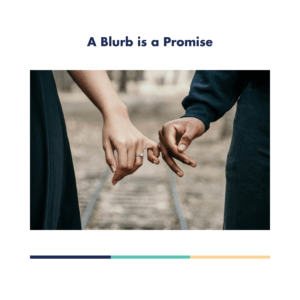
Every story editor should request a blurb from their client prior to starting work on the client’s manuscript.
Sometimes a writer panics when an editor asks for a blurb. The way to alleviate their panic is to define what you mean by a blurb, explain how you’re going to use the blurb and how it will help you deliver a better edit.
When a writer asks you what a blurb is
Here is what I share with my clients.
Think of a blurb as the copy that goes on the back of the published book. This tells the reader what the story is about.
A blurb does not give away the ending of a story. It won’t ruin my first reaction to twists in the story.
It’s a promise to the reader of what to expect from the story.
Why does a story editor need a blurb?
An editor must understand the writer’s intent for the story. The blurb shows the intent. This information is a must if the editor wishes to give the best possible story advice and stay true to the writer’s intention for the story.
The editor can also use the blurb to ensure a writer doesn’t break their promise to the reader. A reader expects the blurb to tell them what the story is about, who the protagonist is, and what’s at stake. Break this promise and a reader may get frustrated and put the book down. When you’re editing, you’ll often refer to the blurb to ensure teh writer stays on track.
Blurbs from famous books
Let’s look at Gone Girl by Gillian Flynn
On a warm summer morning in North Carthage, Missouri, it is Nick and Amy Dunne’s fifth wedding anniversary. Presents are being wrapped and reservations are being made when Nick’s clever and beautiful wife disappears from their rented McMansion on the Mississippi River. Husband-of-the-Year Nick isn’t doing himself any favors with cringe-worthy daydreams about the slope and shape of his wife’s head, but passages from Amy’s diary reveal the alpha-girl perfectionist could have put anyone dangerously on edge.
Under mounting pressure from the police and the media – as well as Amy’s fiercely doting parents – the town golden boy parades an endless series of lies, deceits, and inappropriate behavior. Nick is oddly evasive, and he’s definitely bitter – but is he really a killer?
What is the story about? Nick’s clever and beautiful wife disappears.
Who is the protagonist? Nick. His wife disappears, and her part of the story is written in her diary: passages from Amy’s diary.
What is at stake? Will Nick be charged with murder? The blurb says: Nick is oddly evasive, and he’s definitely bitter – but is he really a killer?
So now we have our promise.
When I edit stories, I sometimes see a writer has inadvertently made a character other than the one they wanted as the protagonist. By having the blurb, an editor understands the writer’s intent and can make sure they achieve it.
The Notebook by Nicholas Sparks
At 31, Noah Calhoun, back in coastal North Carolina after World War II, is haunted by images of the girl he lost more than a decade earlier. At 29, socialite Allie Nelson is about to marry a wealthy lawyer, but she cannot stop thinking about the boy who long ago stole her heart. Thus begins the story of a love so enduring and deep it can turn tragedy into triumph, and may even have the power to create a miracle.
What is the story about? Turning tragedy into triumph.
Who is the protagonist? Noah Calhoun. His love interest is Allie Nelson.
What is at stake? Love. Allie is about to marry someone else.
This is a classic love story. The reader will expect scenes from both character’s points of view. They will expect a struggle, and they will expect true love to win. Imagine if the story was written about Allie actually marrying the lawyer, and Noah losing out on true love. This doesn’t fit the blurb at all. Check out How to Write a Romance Novel to see how a writer might attempt to write a romance in StoryTeller.
Whatever the genre, the reader expects the writer to keep true to the blurb and deliver on their promise to the reader.
Before performing a story edit, ask the writer for a blurb. It’s a must if you want to deliver an exceptional edit.
Ready to Take Your Editing to the Next Level?
A Fictionary StoryCoach helps writers tell a powerful story and makes the writer’s voice shine! You can now try Fictionary StoryCoach for editors for free for one month!
And there’s more. The Fictionary Certified StoryCoach training is available.
Do you want to become a Fictionary Certified StoryCoach? Check out Fictionary Certified StoryCoach Training.
If you’d like to take the training, send me (Kristina) an email at helpful.editor@temp-fictionary.flywheelstaging.com telling me why you’d like to become a Fictionary Certified StoryCoach.
The Fictionary StoryCoach Certification training program helps editors deliver a comprehensive and objective editorial package using StoryCoach software.
We developed this training for two reasons.
- The first is for fiction editors to have a place to learn how to perform a high-quality story edit, get certified, and then have a tool (StoryCoach) that helps them perform exceptional story edits.
- The second is for writers to know they are dealing with a professional editor who understands story when they hire a Fictionary Certified StoryCoach.
For more on story coaching check out: What is a Story Coach?

